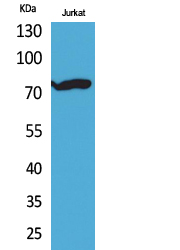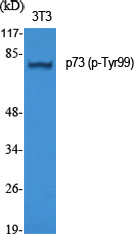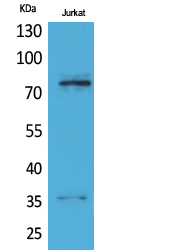Total p73 Cell-Based Colorimetric ELISA Kit
- 货号:KA3166C
- 应用:ELISA
- 种属:Human;Mouse
- 其他名称:
- Tumor protein p73 (p53-like transcription factor) (p53-related protein)
- 背景:
- cofactor:Binds 1 zinc ion per subunit.,disease:Maps to a chromosome region frequently mutated in diverse cell lines of human cancer. Appears not to be frequently mutated in human cancers, in contrast to p53. Hemizygosity is observed in neuroblastoma and oligodendroglioma.,domain:Possesses an acidic transactivation domain, a central DNA binding domain and a C-terminal oligomerization domain that binds to the ABL tyrosine kinase SH3 domain.,domain:The WW-binding motif mediates interaction with WWOX.,function:Participates in the apoptotic response to DNA damage. Isoforms containing the transactivation domain are pro-apoptotic, isoforms lacking the domain are anti-apoptotic and block the function of p53 and transactivating p73 isoforms. May be a tumor suppressor protein.,induction:Not induced by DNA damage. Isoforms lacking the transactivation domain block gene induction.,miscellaneous:Activated and stabilized by interaction with RANBP9.,PTM:Isoform alpha (but not isoform beta) is sumoylated on Lys-627, which potentiates proteasomal degradation but does not affect transcriptional activity.,similarity:Belongs to the p53 family.,similarity:Contains 1 SAM (sterile alpha motif) domain.,subcellular location:Accumulates in the nucleus in response to DNA damage.,subunit:Found in a complex with p53/TP53 and CABLES1. The C-terminal oligomerization domain binds to the ABL tyrosine kinase SH3 domain. Interacts with HECW2. Isoform Beta interacts homotypically and with p53/TP53, whereas isoform Alpha does not. Isoform Gamma interacts homotypically and with all p73 isoforms. Isoform Delta interacts with isoform Gamma, isoform Alpha, and homotypically. Isoforms Alpha and Beta interact with HIPK2. Isoform Alpha interacts with RANBP9. Isoform Beta interacts with WWOX.,tissue specificity:Brain, kidney, placenta, colon, heart, liver, spleen, skeletal muscle, prostate, thymus and pancreas. Highly expressed in fetal tissue.,
- 功能:
- regulation of cell growth, release of cytochrome c from mitochondria, regulation of protein amino acid phosphorylation,response to tumor cell, DNA metabolic process, DNA repair, mismatch repair, transcription, regulation of transcription, DNA-dependent, negative regulation of protein kinase activity, apoptosis, induction of apoptosis, defense response,inflammatory response, response to DNA damage stimulus, mitochondrion organization, cell cycle, cell cycle arrest,intracellular signaling cascade, body fluid secretion, cell death, regulation of cell size, induction of apoptosis by intracellular signals, DNA damage response, signal transduction resulting in induction of apoptosis, apoptotic mitochondrial changes, response to wounding, post-embryonic development, positive regulation of biosynthetic process, positive regulation of macromolecule biosynthetic process, positive regulation of mac
- 细胞定位:
- Nucleus . Cytoplasm. Accumulates in the nucleus in response to DNA damage.
- 组织表达:
- Expressed in striatal neurons of patients with Huntington disease (at protein level). Brain, kidney, placenta, colon, heart, liver, spleen, skeletal muscle, prostate, thymus and pancreas. Highly expressed in fetal tissue. Expressed in the respiratory epithelium (PubMed:34077761).



